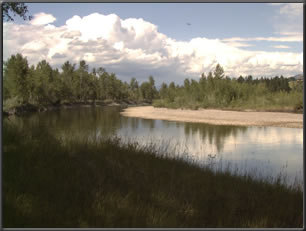Riverine
 Riverine wetlands occur in floodplains and riparian corridors in association with stream channels. Dominant water sources are overbank flow from the channel or subsurface hydraulic connections between the stream channel and wetlands. Additional sources may be interflow, overland flow from adjacent uplands, tributary inflow, and precipitation. When overbank flow occurs, surface flows down the floodplain may dominate hydrodynamics. In headwaters, riverine wetlands often intergrade with slope wetlands, depressions, poorly drained flats, or uplands as the channel (bed) and bank disappear. Perennial flow is not required. Riverine wetlands lose surface water via the return of floodwater to the channel after flooding and through surface flow to the channel during rainfall events. They lose subsurface water by discharge to the channel, movement to deeper groundwater (for losing streams), and evaporation. Peat may accumulate in off-channel depressions (oxbows) that have become isolated from riverine processes and subjected to long periods of saturation from groundwater sources. Bottomland hardwoods on floodplains are an example of riverine wetlands.
Riverine wetlands occur in floodplains and riparian corridors in association with stream channels. Dominant water sources are overbank flow from the channel or subsurface hydraulic connections between the stream channel and wetlands. Additional sources may be interflow, overland flow from adjacent uplands, tributary inflow, and precipitation. When overbank flow occurs, surface flows down the floodplain may dominate hydrodynamics. In headwaters, riverine wetlands often intergrade with slope wetlands, depressions, poorly drained flats, or uplands as the channel (bed) and bank disappear. Perennial flow is not required. Riverine wetlands lose surface water via the return of floodwater to the channel after flooding and through surface flow to the channel during rainfall events. They lose subsurface water by discharge to the channel, movement to deeper groundwater (for losing streams), and evaporation. Peat may accumulate in off-channel depressions (oxbows) that have become isolated from riverine processes and subjected to long periods of saturation from groundwater sources. Bottomland hardwoods on floodplains are an example of riverine wetlands.
Example Subclasses

Back to HGM Approach
Web Date: October 1997
Updated: February 2022
|

